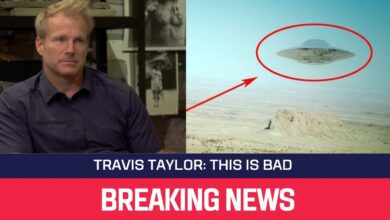Metal Being Beneath the Mesa? Skinwalker Ranch’s Most Shocking Discovery Yet
Metal Being Beneath the Mesa? Skinwalker Ranch’s Most Shocking Discovery Yet

The enigmatic landscape of Skinwalker Ranch continues to baffle experts and thrill viewers with its ever-deepening mysteries.
Each season seems to peel back another layer of the unknown.
And the most recent episode of The Secret of Skinwalker Ranch delivered perhaps the most jaw-dropping revelation yet.
A startling discovery inside the mesa left even seasoned scientists like Dr. Travis Taylor momentarily speechless and may represent the strongest indication to date that something unnatural—perhaps even engineered—is embedded deep within the terrain.
This stunning development began with a key visit from Chris Bartell, a former security officer who had worked the ranch during the high-security era of aerospace mogul Robert Bigelow’s ownership.
Bartell’s testimony carried unusual weight. He wasn’t a casual observer, but someone who had patrolled the property under intense secrecy, privy to the rhythms of a place most people only knew from legend.
Pointing the team to a particular section of the mesa, Bartell described a spot where, years earlier, a large cave entrance had been mysteriously sealed off overnight.
He recounted how, during his tenure, the area had been under quiet surveillance and how activity around it had never been explained.
What could have been hidden or deliberately buried there? And perhaps more importantly, who did the burying?
The implications were enormous.
A sealed cavern could indicate an ancient geological anomaly, a cache of human-made artifacts, or something stranger still—especially given the ranch’s long history of unexplained phenomena and government interest.
Determined to break through decades of rumor and finally uncover the truth, the team enlisted Aaron and his crew from Straight Shot Drilling, specialists in precision excavation.
Unlike the vertical boreholes the team had drilled in earlier experiments, this new operation called for horizontal drilling—an approach rarely attempted at the ranch.
The plan was bold: push a bore directly beneath the main road and canal, then angle upward into the flank of the mesa, targeting the exact coordinates Bartell had identified near the now-covered cave entrance.
The decision was more than just tactical—it was born of necessity.
Previous vertical drilling attempts had yielded puzzling data: unexplained spikes in gamma radiation, odd electromagnetic readings, and abrupt mechanical failures of equipment—as if the ground itself resisted intrusion.
By drilling horizontally, the team hoped to bypass whatever was interfering from above and sneak into the mesa at an oblique angle, almost like tunneling into a buried vault without triggering its defenses.
As the drill began its slow, grinding journey into the rock, tensions ran high.
Instruments were calibrated to monitor for spikes in magnetic fields, air pressure, and radiation levels—any hint of the strange forces that have defined the ranch for decades.
Crew members watched nervously as real-time telemetry from the borehole appeared on screens.
The deeper the drill advanced, the more erratic the readings became: localized electromagnetic surges, unexplained static on communication lines, and intermittent flickers on the team’s video feeds.
It was in this fraught atmosphere that the breakthrough occurred—a moment when the drill struck a hard, metallic-sounding object far below the surface.
The bit slowed and sensors spiked.
To everyone’s shock, the material did not behave like normal rock.
Its density and reflective properties were unlike anything the geologists on site could immediately identify.
When fragments were retrieved from the drill’s core barrel, they glittered strangely under the field lights, unlike any natural sample from the mesa before.
For Dr. Travis Taylor—normally composed and methodical—the moment was electric.
He examined the fragments and paused, a rare beat of silence from the usually quick-to-speculate physicist.
“This,” he finally said, “shouldn’t be here.”
The look on his face said everything.
Was this metallic anomaly part of a naturally occurring ore deposit shaped by some exotic geologic process?
Or was it, as some whispered, a piece of buried technology—perhaps from a time or an origin not yet recognized by mainstream science?
The mesa, long rumored to be more than just rock and soil, may now hold its first tangible proof of something extraordinary.
What the team unearthed could rewrite the narrative not only of Skinwalker Ranch, but of how we think about the boundaries between the natural and the engineered, the terrestrial and the otherworldly.
As the drill crept forward, the sense of anticipation among the team was almost palpable.
Every foot advanced carried with it the possibility of breaching a void—perhaps one containing remnants from the Bigelow era, sealed-off materials, unknown structures, or something far stranger.
At around 80 feet in, however, the operation began to veer sharply from expectations.
Over 2,000 gallons of drilling fluid had been pumped into the borehole to lubricate the bit and carry rock cuttings back to the surface.
Yet none of it was returning.
The pumps continued to run, the gauges read full pressure—but the outflow remained stubbornly dry.
It was as if the liquid had simply vanished.
The crew speculated in hushed tones that they might have punctured a hidden cavity, a void so large it could swallow thousands of gallons without a trace.
This possibility set nerves on edge.
Underground voids can destabilize drilling operations—but at Skinwalker Ranch, such an anomaly might mean far more than geology.
Almost simultaneously, strange behavior began manifesting in the equipment—familiar yet no less unsettling.
Readouts flickered. Communication links stuttered.
Control panels flashed warning lights with no identifiable cause.
It was a chilling echo of the ranch’s long history of bizarre electromagnetic disruptions whenever its hidden depths were probed too aggressively.
Back at the main command center, Dr. Travis Taylor and principal investigator Eric Bard monitored the telemetry on multiple screens.
Then came an unmistakable sign—the return of the persistent 1.6 GHz signal, the same mysterious frequency that had plagued prior experiments, especially those conducted near Homestead 2.
This signal had become something of a calling card for the ranch’s strangeness.
Historically, its appearance coincided with sightings of anomalous lights, unexplained equipment failures, and even sudden illnesses among personnel.
The pattern was undeniable: whenever the 1.6 GHz signal appeared, something happened.
And now, at the very moment the drill was penetrating deep into the mesa, the signal was back—strong and clear.
Determined to correlate the phenomena in real time, Taylor dispatched team members Tom Lewis and Brian “Dragon” Arnold to Homestead 2 with an array of instruments…
Tom Lewis and Dragon Arnold’s toolkit reflected the multidisciplinary nature of the investigation:
a Geiger counter to track potential radiation spikes,
a TriField meter for electromagnetic field fluctuations,
a lightning detector to pick up electrical discharges,
and most crucially, an RF spectrum analyzer designed to map and characterize radio signals across a wide frequency band.
What began as a routine data-gathering mission quickly turned alarming.
As the men set up their instruments in the twilight glow near the weathered homestead structures, readings spiked unpredictably.
The TriField meter swung wildly.
The Geiger counter ticked erratically, though not at levels immediately hazardous.
But it was the RF spectrum analyzer that produced the most disturbing anomaly of all.
This device was designed only to receive and measure radio signals.
It had no transmitter, no ability to broadcast.
Yet, as Tom Lewis and Dragon Arnold stood over it, the unit began emitting its own signal—broadcasting outward on the very same 1.6 GHz frequency they had come to measure.
It was as though the equipment had been hijacked, repurposed, or forced into a mode it wasn’t physically capable of operating in.
Lewis looked at Dragon in disbelief.
“It’s not just picking up the signal,” he said quietly. “It’s sending it back, at command.”
Taylor and Bard could see the anomaly unfolding on their monitors, their expressions hardening.
If the signal was somehow using or altering their gear to propagate itself, this wasn’t just a passive phenomenon.
It was interactive—responsive—possibly intelligent.
The implications were staggering.
What or who was on the other end of that 1.6 GHz transmission?
And why did it always appear when the team pressed hardest into the ranch’s secrets?
This shouldn’t happen under normal conditions.
Moments later, Tom Lewis experienced a terrifying episode.
Without warning, he blacked out, collapsing to the ground as his left arm went numb and his heart raced erratically.
The team rushed to his side, frantically checking vitals and calling emergency services.
At the hospital, doctors ran every test they could, but no clear cause was identified.
His heart continued to skip beats intermittently—a serious red flag that left both medical staff and the investigation team unsettled.
Whether coincidence or not, the episode occurred immediately after prolonged exposure to the anomalous frequencies and the bizarre equipment behavior, raising troubling questions about the very real physiological dangers associated with exploring the ranch.
Despite the scare, the team pressed on, their resolve steeled by the possibility of uncovering something extraordinary.
Drilling continued into the mesa, each rotation of the bore head pushing farther toward the long-sealed cave entrance.
Slowly, the muddy slurry from the borehole began to return, collected in a specially prepared catchment area lined with a fine mesh screen designed to trap even the smallest debris.
What emerged was immediately unsettling.
Among the wet sediment were thin metallic flakes—delicate yet strangely rigid, their surfaces glinting in the harsh light of portable work lamps.
One piece, larger than the rest, drew all eyes.
Its surface was pitted with brownish rust-like streaks, yet other areas were smooth, jet-black, and almost glassy, reflecting light in an unnatural way.
The texture and composition defied immediate classification.
It was unlike any known natural rock or mineral formation, the team speculated in hushed tones.
Could these be remnants of human technology lost decades ago?
Or perhaps artifacts from something far older—or even extraterrestrial?
The flakes were brittle, yet seemed to resist ordinary breakage—bending physics as much as the imagination.
Every instinct told the team they were holding a piece of a puzzle that could redefine everything known about the ranch.
As drilling continued and more fragments were retrieved, subtle phenomena persisted.
Instruments continued to twitch, lights flickered, and the low hum of unidentifiable frequencies filled the mesa.
It was as if the ranch itself were alive, responding to each intrusion into its depths, offering tantalizing glimpses of secrets that might have remained buried forever.
The discovery of these metallic fragments—paired with the bizarre equipment responses and the 1.6 GHz signal—marked a turning point.
No longer were they simply observers of anomalies.
They were engaging directly with something that defied conventional explanation—an interactive environment that seemed to blend geology, technology, and something far stranger.
It looked almost manufactured, processed—its surface far too precise and irregular at the same time to be a product of simple geology.
The brittle metallic fragment seemed like a relic from another age—or another world entirely.
To identify its composition, Dr. Taylor retrieved a handheld X-ray fluorescence (XRF) analyzer, a device capable of reading the elemental signature of a material by firing X-rays at it and interpreting the energies reflected back.
This was no ordinary test.
In seconds, the analyzer could reveal the elemental story of a substance that had been hidden for centuries—or perhaps millennia—inside the mesa.
The first scan returned an unexpected yet partially familiar signature:
calcium, silicon, aluminum, magnesium—and a significant percentage of iron.
But one reading made everyone pause: 26 % iron and 8 % aluminum on one side of the fragment.
Already unusual for something supposedly trapped deep inside a natural mesa.
But the real shock came when Taylor turned the sample over and scanned the blackened, glassy surface.
The XRF readout jumped to 72 % iron—essentially indicating solid metal rather than mineral-laced rock.
Taylor’s eyebrows rose as the numbers registered.
“What is metal doing coming out of the hill 300 feet in?” he asked, astonishment breaking through his usually methodical tone.
The question hung in the air—heavier than the fragment in his gloved hand.
This discovery had enormous implications.
The mesa is a natural geological formation — or so it has always been classified.
Yet here, embedded hundreds of feet inside it, was what appeared to be refined, highly concentrated metal.
Such material doesn’t form naturally under these conditions.
The possibilities ran like electricity through the command center.
Could it be part of an ancient, long-buried structure?
Debris from a meteorite impact?
Or something far stranger — perhaps remnants of a crashed object of non-terrestrial origin?
For decades, Skinwalker Ranch has been synonymous with speculation: a nexus for theories ranging from hidden underground bases to interdimensional portals and extraterrestrial craft.
This find pushed those theories from speculation to the edge of evidence.
If refined or manufactured metal existed inside a supposedly untouched mesa, it could mean the land had been altered — perhaps mined, constructed upon, or even seeded with technology long before any modern intrusion.
Adding to the strangeness was the context of the discovery itself.
The metallic fragments weren’t just sitting inertly inside the mesa.
They were retrieved during an operation already accompanied by electromagnetic anomalies, equipment malfunctions, and a potentially life-threatening medical episode.
The environment seemed reactive — almost aware — as if the very act of drilling had provoked a response.
This wasn’t just another oddity in the long list of Skinwalker’s mysteries.
It was tangible, measurable, and possibly testable — an artifact that could either confirm or dismantle decades of wild speculation.
Whatever its origin, the blackened fragment now held in Taylor’s gloved hands represented a pivot point in the investigation.
The team had reached deeper into the mesa than anyone before — and come back with something that did not belong.
The presence of strange radio signals, bursts of anomalous radiation, and unexplained physical effects on personnel has led some to theorize that alien technology — or at the very least, technology unknown to modern science — might be buried beneath the surface of Skinwalker Ranch.
Some speculate it could even still be operational, pulsing silently within the mesa as it has for centuries or millennia.
Dr. Travis Taylor, with his rare combination of aerospace engineering expertise, advanced physics training, and firsthand experience working with the Pentagon’s UAP task force, has remained publicly cautious about making leaps to conclusions.
Yet even he seemed visibly unsettled by this latest discovery.
“We’re seeing the same signals we’ve recorded before — signals that always correlate with strange events,”
Taylor said as he examined the metallic fragments.
“We’ve got equipment behaving in ways that defy explanation. Now we’ve pulled metal out of the mesa.”
He looked at the data scrolling across the monitor, his voice tightening.
“This isn’t anecdotal anymore. This is physical evidence.”
Indeed, the pattern was unmistakable.
Every time the 1.6 GHz frequency appeared, the ranch’s strange phenomena seemed to escalate: equipment glitching, batteries draining, drones failing mid-air — and, in the most serious cases, physical harm to team members.
Tom’s sudden blackout and cardiac irregularities after exposure to the signal underscored the stakes.
This was no longer just about measuring unusual readings.
The investigation itself had become dangerous.
The implications of this convergence — electromagnetic interference, unexplained health effects, and now the recovery of metallic materials of unknown origin — suggested that something far more unusual than random geology was at work inside the mesa.
Was it a buried craft, a network of structures acting like a giant antenna, or something older and stranger still?
Perhaps a forgotten technology from an ancient civilization?
Some on the team whispered a darker possibility: that the mesa wasn’t just hiding something but actively responding to being probed — its strange behavior more like a defensive system than a passive anomaly.
The idea seemed far-fetched, yet the data couldn’t be ignored.
Whenever the team’s experiments intensified, the 1.6 GHz signal strengthened — as if something beneath the Earth was not only aware of their actions, but reacting to them.
Taylor, ever the scientist, wrestled with this tension.
On one hand, the evidence demanded hard, repeatable testing.
On the other, the phenomena appeared to escalate with each attempt.
The mesa was no longer just a mystery to be solved.
It had become an adversary — or at least an active participant in the investigation.
Theories abound.
Some proposed that the mesa may conceal a buried object of extraterrestrial origin — perhaps the shattered remnants of a craft or a still-functional piece of alien technology that has lain dormant for centuries.
Others suggest a secret underground installation, its origins lost to time, or a naturally occurring geophysical anomaly whose properties mimic technology far beyond our current understanding.
In every scenario, one point remains undisputed: the mesa is not what it appears to be on the surface.
Dr. Taylor and the rest of the team agree on one thing — the mesa holds secrets that must be uncovered, regardless of the risks.
Each new phase of testing, from ground-penetrating radar sweeps to horizontal drilling, has peeled back another layer of mystery — but at a cost.
Equipment failures, unexplained health effects, and anomalous signals seem to escalate in proportion to the intensity of the investigation, as if some hidden force beneath the Earth resists exposure.
Yet the stakes are too high to turn back.
The discovery of metallic fragments embedded deep within the mesa has shifted the investigation from speculation to tangible evidence.
The next steps will involve a painstaking forensic analysis of the recovered material — running it through high-resolution electron microscopy, mass spectrometry, and isotope-ratio testing to determine not just its composition, but its origin.
Cross-referencing the alloy with known industrial materials, meteorite databases, and classified defense inventories will help determine whether it is terrestrial, meteoritic, or something unprecedented.
If the fragments fail to match any known alloys used on Earth, or are found to contain exotic isotopic ratios inconsistent with terrestrial materials, it could be the long-sought smoking gun — hard proof that the phenomena at Skinwalker Ranch are not merely legend, but the result of advanced technology.
For now, the metal remains an enigma, shimmering on the mesh screens like evidence from another world.
Its discovery has reignited both speculation and scientific curiosity in equal measure, drawing renewed attention from aerospace analysts, physicists, and government insiders who have watched the ranch from afar for decades.
Whatever lies beneath Skinwalker Ranch, the evidence is mounting that it is not simply folklore.
And the team’s next steps may bring them closer than anyone has ever been to uncovering the truth.
It’s real — and it’s reacting.
Stay tuned, because the mesa may be hiding the most compelling evidence yet that something not of this Earth once touched down on the Utah desert — and perhaps still lies dormant beneath its surface.
The discovery of strange metal deep inside the mesa is just the latest chapter in a decades-long saga of baffling phenomena surrounding Skinwalker Ranch — phenomena that resist explanation through any known framework of conventional science.
More than just unexplained lights or fleeting sightings, many researchers now believe that invisible forces may be at work beneath the surface.
These forces appear to affect the environment in measurable ways, disrupting electronic devices, scrambling GPS signals, and even altering the perception and biology of those who venture too close.
Temporary cognitive disorientation, inexplicable skin burns, headaches, and nausea have been reported by personnel — hinting at some form of interaction between the unseen energy and the human nervous system.
Could these forces be remnants of an advanced technology left by an ancient civilization long forgotten?
Or are they manifestations of naturally occurring fields that modern physics has yet to fully understand — fields tied to theories of quantum vacuum fluctuations or zero-point energy?
The mesa itself may not just be a geological formation, but a vast, layered reservoir of exotic energy — or even a shielding structure designed to contain it.
Some scientists and theorists go further still.
They’ve speculated that Skinwalker Ranch might be home to a naturally occurring or artificially engineered space-time distortion — a so-called “space gate” or wormhole.
This would provide a startlingly elegant explanation for the erratic signals, the recurring 1.6 GHz frequency spikes, the time slips reported by witnesses, and the spontaneous appearances of unidentified aerial phenomena documented over the years.
If true, the mesa would not merely be hiding evidence of alien technology — it could be a gateway to somewhere or something else entirely.
For now, the metallic fragments extracted from deep inside the mesa stand as tantalizing clues.
Are they debris from a long-buried craft, components of a containment system, or artifacts from a time when our planet was not as isolated as we believe?
The next round of laboratory testing — examining isotopic ratios, crystalline lattice structures, and electromagnetic properties — may bring the team closer to an answer than ever before.
But as every new finding has shown, the mesa seems to react when it is probed.
And the deeper they go, the higher the stakes become.
If a gateway or portal truly exists within the mesa, it might not simply be a passage through space.
It could be a corridor through time, dimension, and even consciousness itself — a place where the known laws of physics bend just enough to allow glimpses of other realities.
One can imagine a hidden threshold where timelines overlap — where history took different turns — or where beings from worlds we have yet to discover coexist with ours unseen.
The legends of the Ute tribe, who for generations warned against setting foot on the land now known as Skinwalker Ranch, take on a haunting new resonance in this light.
Their stories spoke of skinwalkers — mystical shapeshifters, dark spirits, and malevolent entities that could slip between forms.
For centuries, these were dismissed as folklore.
But what if these myths were not symbolic tales at all, but encoded memories of encounters with interdimensional beings or anomalies emerging from the mesa itself?
Eyewitness reports collected over decades at the ranch describe creatures and phenomena that defy biology and logic alike:
huge wolf-like animals impervious to bullets stalking the periphery of the property,
humanoid figures that glow faintly in the darkness before vanishing into thin air,
orbs of light — some as small as marbles, others the size of basketballs — that drift silently and appear to exhibit intelligence, responding to observers and equipment as though aware they’re being watched.
Could these manifestations be guardians of a hidden portal?
Or are they residual echoes — byproducts of whatever force or technology lies entombed beneath the mesa?
Adding to this mystery are the unsettling layers of government involvement.
During Robert Bigelow’s tenure, Skinwalker Ranch became a discreet hub of high-level investigation — its operations funded under the Pentagon’s Advanced Aerospace Threat Identification Program (AATIP) and its closely related initiative, AAWSAP.
Internal documents and whistleblower testimonies have since hinted at a startling hypothesis: certain areas of the ranch may act as amplifiers or conduits for phenomena not yet understood by mainstream science.
Military contractors, deeply intrigued, were not just studying these effects — they were quietly exploring whether such phenomena could be replicated, controlled, or even weaponized.
If this is true, Skinwalker Ranch is not merely a hotspot of the unexplained.
It may be a rare convergence zone where ancient legend, advanced technology, and classified research collide — a living laboratory whose boundaries stretch beyond space and time.
Could the strange metal fragments recovered from deep inside the mesa be linked to black-budget technology experiments — classified projects buried so deep in secrecy that even their existence is denied?
Or is it something far older, something so alien in origin that it transcends our understanding of engineering and metallurgy altogether?
The question hangs in the air like a static charge — unspoken yet palpable among the team as they sift through every clue.
Equally unsettling are the temporal distortions reported again and again by multiple witnesses.
Time at Skinwalker Ranch does not always behave as expected.
It slows down, speeds up, or even seems to vanish altogether.
GPS data inexplicably drifts out of sync.
Precision clocks used to time experiments register discrepancies of seconds or minutes.
Drone footage emerges with missing frames, and experiment logs become corrupted without apparent cause.
These aren’t isolated incidents — they’re patterns, reappearing like a ghost in the machine.
If the mesa truly sits on a fault line between dimensions or timelines, the team may be witnessing a phenomenon physicists barely dare to hypothesize — “slippage,” a bleed-through effect where our universe intersects with another.
This could explain why events and phenomena on the ranch are elusive — always changing their form, always appearing just beyond reach.
Orbs vanish when pursued.
Electromagnetic spikes shift locations.
Anomalous creatures seem to flicker between states of being.
For those driven by scientific curiosity, Skinwalker Ranch represents the ultimate puzzle.
It’s not just a location — it’s an interface between the frontiers of physics, consciousness, and metaphysics.
Each new discovery — a mysterious signal, a metallic fragment, an unexplained health event — erodes the boundary between science fiction and reality.
What if the team isn’t simply observing these phenomena, but actively interacting with them?
What if the mesa is less an object of study than a participant in the study itself — an intelligent system responding to their efforts?
Increasingly, Skinwalker Ranch is beginning to look less like a single mystery and more like a laboratory for unlocking hidden truths about matter, time, and even the structure of consciousness itself.
The signals, the distortions, and the risks all point to a deeper system at work — something capable of warping not only instruments, but perception and biology.
As Dr. Travis Taylor and his team prepare for the next phase of investigation, the world watches with bated breath.
This is no longer just a TV series or an odd story from the Utah desert.
It is becoming a scientific odyssey into the unknown — a test of how far our understanding of reality can stretch before it breaks.
The mesa, with its buried signals and enigmatic metal, has become a symbol of humanity’s hunger to understand the universe at its most mysterious.
Whether it leads to the discovery of alien technology, evidence of ancient civilizations, or an entirely new model of the cosmos itself, one thing is clear:
Skinwalker Ranch is rewriting the boundaries of what we know — and what we dare to believe.








